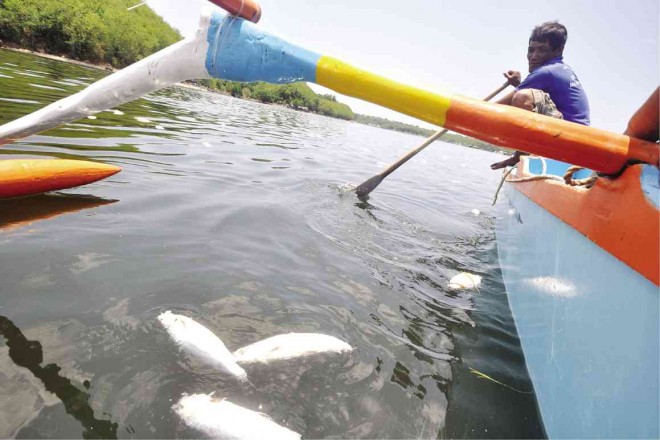
A FEW bangus float on the Kakiputan Channel in Bolinao, Pangasinan, during a fish kill in the area last month. WILLIE LOMIBAO/INQUIRER NORTHERN LUZON
LINGAYEN, Pangasinan—The Bureau of Fisheries and Aquatic Resources (BFAR) has asked officials in Pangasinan to adopt stricter management policies in the province’s aquaculture areas to avoid a repeat of devastating fish kills.
Nestor Domenden, BFAR regional director in Ilocos, said he has been reiterating this in a series of meetings with aquaculture operators in the province following the massive fish kill that hit the towns of Bolinao and Anda last month.
“Let’s not accommodate any more requests in fish production areas. If we have agreed on a ‘no fish pen’ policy, then there should be no fish pen, no other structure that will block the flow of water,” Domenden said.
On April 25, bangus (milkfish) worth at least P220 million in 390 pens and cages at the Kakiputan Channel, a body of water separating Anda and Bolinao towns, went belly up because of low dissolved oxygen levels.
“This has been a cycle and it has kept coming back,” said Domenden.
The first massive fish kill in the area took place in 2002 when some P400 million worth of bangus died, wiping out the town’s bangus industry at that time. In 2011, another massive fish kill destroyed P44.17 million worth of bangus in the same area.
Domenden said water quality there deteriorated last month. “It was a combination of the effect of neap tide, continuous decomposition of organic matters at the bottom of the channel and plankton bloom,” he said.
At the time of the fish kill, BFAR had just lifted its red tide alert in Bolinao and Anda and had cleared the sale and consumption of shellfish gathered from the two towns.
Domenden said it was not the number of cages and pens in the channel that had caused the fish kill but the way they were arranged.
“Although we had the right number of pens and cages in the area, the number of stationary structures and shellfish farms increased,” he said. Gabriel Cardinoza, Inquirer Northern Luzon